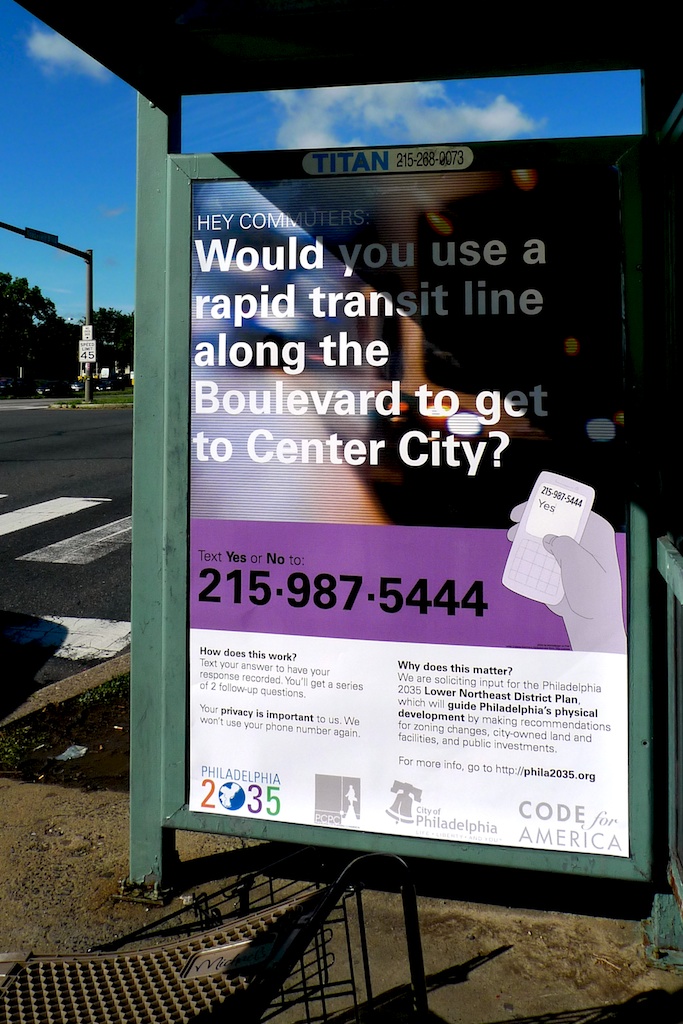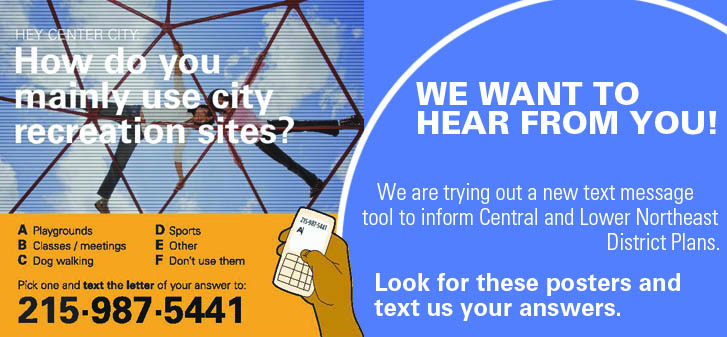Can apps and social media work as planning tools?
Clint Randall, a planner with the Philadelphia City Planning Commission, talks with PlanPhilly about the Commission’s recent experiences with an innovative texting program created for the City by Code for America, a nonprofit that sends young techies out to cities interested in building apps and using social media.
This year, they helped Philadelphia with three projects. “Textizen” for the Planning Commission, “Where’s My Septa?, a scheduling app for Septa, and “NeighborHow,” a crowd-sourced app that encourages neighbors to share best practices such as organizing a block cleanup, hosting a block party, or starting a neighborhood watch.
PP: You’ve just returned from Code for America’s annual summit. Any takeaways?
CR: Well, it was really cool for the city because Mayor Nutter was the keynote speaker. I also learned that we’re the only city that’s worked with Code for America two years in a row. I was part of a panel to discuss “Textizen,” and since then, I’ve heard, there have been 120 expressions of interest from other cities and groups in starting a similar program!
PP: So, tell us a little more about Textizen.
CR: The whole point was to look for a way to talk to more people while skirting issues of the digital divide. Using a communication tool based primarily on texting accomplishes that since everyone these days has a cellphone. We developed three separate questions, and ran them for two months each. Our work was centered on the new district plans that will be looking at pretty much every aspect of the physical environment, including recommendations that will have implications for the Parks and Recreation department, Septa, and other agencies.
PP: Tell us a little more about the one that I first noticed, the one designed to get info on recreation center use.
CR: Sure. As neighborhoods have grown and filled in and the demographics have changed, we feel anecdotally that the way people are using the rec centers and want to use them is changing, so we wanted to take the pulse on that.
PP: How’d it work?
CR: It started with, as you noticed, a question on a poster. Then once someone texted his or he answer, they got into a bit of a discussion with a few followup questions. It ended with us asking them to tell us which neighborhood they live in.
PP: And what did you learn?
CR: We haven’t done any statistical analysis yet, but it’s interesting to see how many people use the rec centers for dog walking — maybe a full third of respondents. But that’s not something the centers are designed for. So if we see that, say, people in Fairmount are saying they walk their dogs at the rec center, we might recommend that Parks & Rec reconceptualize one of the rec centers in the area. Maybe we can re-think if there’s too many asphalt surfaces, or maybe we don’t need two baseball fields, or is there a city-owned property in the neigborhood that can be transform into space for a dog run?
PP: What was the second question?
CR: It centered on what people would want to see to make Center City more kid-friendly. This one was pretty opened ended on our part, unlike the rec center question, which was more multiple choice. I was pleased and surprised to see that in addition to the bigger policy issues — like better schools —a lot of people got it and talked about built environment issues that contribute to or detract from kid-friendliness. We got suggestions like, what about safer, buffered bike lanes so I can help my kids bike to school? or safer crosswalks so I feel more comfortable with a stroller? or can we have more parking near kid attractions? and why don’t we have a movie theater downtown?
PP: Did this type of question work better?
CR: Yes, without the prompts, we got more suggestions and ideas. I think, moving forward, if we want to dig into a subject a little more, we have to consider how many back and forths we ask people to answer. We’re just testing the waters, but it seems like the open-ended questions get more in-depth responses.
PP: What was the last question?
CR: That was for Lower Northeast plan that we just adapted. It returned to the age old question of rapid transit on Roosevelt Boulevard. We asked, if rapid transit existed — we were very careful not to specify el, subway, or bus rapid transit -—would you ride it to Center City? Then, there was a followup asking the rider if he’d be willing to transfer to the Broad Street line for that trip — implying that this might not be just one ride. We concluded by asking for their home zip codes instead of their neighborhood.
PP: How’d this one turn out?
CR: It was by far our most successful question, we got more than 700 respondents, compared to about 100 for each of the other two projects. It was another great lesson. We put it on Septa buses, and at the entrance to the Frankford Transporation Center, where there are captive audiences. So where possible from now on, we’re going to partner with Septa to use any empty advertising spaces.
PP: So, what’s next?
CR: We’re in the process of developing a series of questions for the University City/Southwest district — it depends on Septa’s availability, how many vehicles can we use, how much ad space is there. We’re trying to do this for little to no money, so we’re not planning to purchase any ad space. But this makes perfect sense for the area because it has great transit coverage…el, trolley, high volume bus routes.
PP: Do you have to work with Code for America again to go forth?
CR: No, the program basically is open source — they want as many people using it as there is interest. We’ve worked out the kinks and gotten them to make last minute changes, so now we have that in place, it’s a very simple computer program where we just type in the questions and it generates a phone number. Then all we have to do is revise the posters. After that, the answers are compiled by the program, it reviews words that come up most often, that kind of thing; and it sorts by zip code and neighborhood, produces charts and bar graphs, and even can publish those answers in real time.
PP: You’re a fan!
CR: Yes, it’s yielded a lot by opening up a whole new audience and really relating to the other communications efforts we have ongoing. It’s more evidence that people are interested and willing to engage if you do it in a format that works for them, whether social media like Facebook or Twitter, or our blog, or texting. Anything that gets more Philadelphians thinking about planning and excited about it is ok by me. Even though this method is not as deep, it’s not giving us as rich data as we can get from speaking at length with someone at a public meeting, we’re reaching so many more people. That’s especially useful as we’ve learned if we apply the technology to site-specific questions. It has applications beyond planning — it could be really useful for agencies that are more on the ground than we are and want to ask a question about a certain facility, or a zoning change, or a change in a transit route, those kinds of things.
Contact the reporter at jgreco@planphilly.com and follow her on Twitter @joanngreco
WHYY is your source for fact-based, in-depth journalism and information. As a nonprofit organization, we rely on financial support from readers like you. Please give today.









